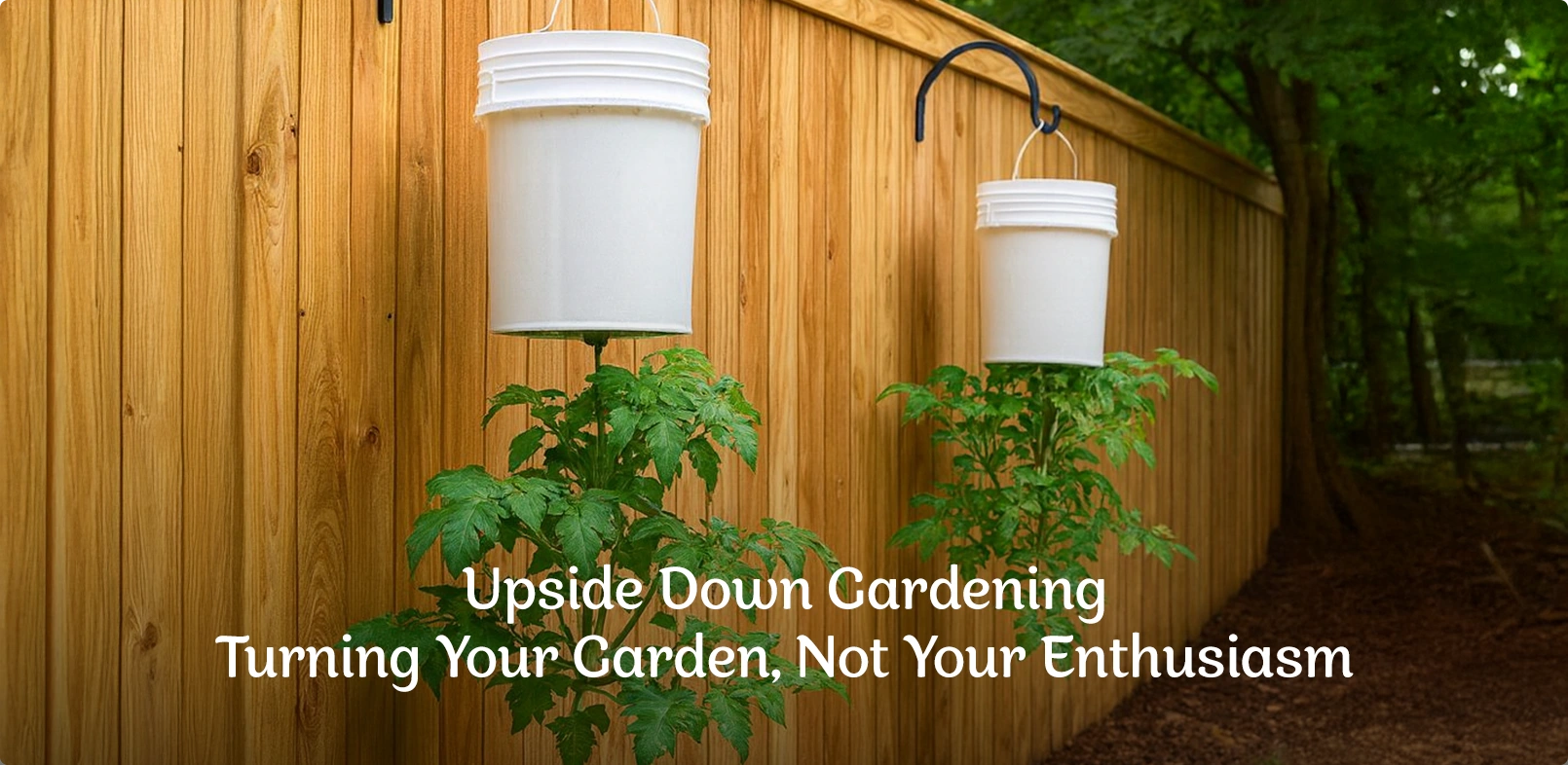
- By: admin
- Comments (0)
- Jul 28
Upside Down Gardening: Turning Your Garden, Not Your Enthusiasm
Gardening has always been a matter of coming up with creative solutions for growing plants well—and upside down gardening is evidence of just how creative plant enthusiasts can be. From patios to balconies, upside down gardening presents a new and space-efficient way to grow herbs, vegetables, and even flowers. For anyone who is space-constrained or simply likes a little something different from conventional gardening, this method is a game-changer.
What is upside-down gardening?
As the name indicates, upside-down gardening is growing plants from hanging planters in a top-to-bottom orientation. The roots are at the top (within the planter) and the plant emerges downward through an opening at the bottom. This technique is particularly favored for some vegetables and vining plants, providing a tidy and easy means of gardening—no plots or beds needed.
Upside Down Gardening Concepts to Attempt
Prepared to flip your garden upside down? Try these ideas to get your upside down garden started:
DIY Hanging Buckets: Utilize abandoned paint buckets or pots and drill holes at the bottom for the roots to grow through.
Upside Down Tomato Planters: Ideal for tomatoes—simply hang them from your balcony rail.
Hanging Bottle Garden: Cut and flip plastic bottles for tiny herbs or flowers.
Vertical Hanging Chains: Hang several upside down planters along a sturdy vertical rod or chain.
Mixed Hanging Garden: Group herbs, flowers, and small vegetables in several upside down planters for an abundance of color.
Upside Down Gardening Benefits
There’s more to this offbeat practice than conserving space. Here are some compelling benefits:
Saves Space: Ideal for apartments, balconies, or tiny patios.
No Weeding Required: Soil is above the plant, reducing weed growth.
Improved Air Circulation: Hanging plants are less susceptible to soil-borne diseases.
Fewer Pest Issues: Several pests can’t access hanging or raised plants.
Water Efficiency: A proper watering plan and water will seep all the way to the roots.
Cleaner Harvests: Produce and vegetables don’t touch the ground, so they remain clean and unscathed.
Less Back Strain: No bending or digging needed.
Cool Aesthetic Appeal: Provides a trendy, sleek touch for your garden design.
Higher Yields in Small Spaces: Produce multiple plants even with small square footage.
Ideal for Beginners: Easy to set up with easy-to-care-for plant options.
To maintain your upside down plants in good health, feed them from time to time with NPK fertilizer, which will give them the necessary nutrients to stimulate root growth, leaf expansion, and flowering/fruiting.
Best Plants for Upside Down Gardening
Not all plants are suitable for this technique, but many grow beautifully upside down:
Vegetables
Tomatoes (cherry tomatoes in particular)
Peppers
Eggplant
Cucumbers (smaller types)
Beans
Zucchini
Herbs
Basil
Oregano
Thyme
Mint
Parsley
Flowers
Petunias
Indian Cress
Fuchsias
Lobelia
Just keep in mind, since the roots are in limited spaces and tend to get exposed to heat, applying a balanced NPK fertilizer becomes crucial for healthy plants.
Types of Upside Down Gardening Systems
There are several systems based on your creativity and resources available:
DIY Bucket Planters: The most popular type, constructed from used buckets or pots.
Upside Down Grow Bags: Breathable and lightweight fabric grow bags.
Vertical Chains: Several upside down planters suspended vertically.
Wall-Mounted Systems: Mount upside down containers against a sturdy garden wall or fence.
Commercial Upside Down Kits: In stores, specifically designed for this method.
Methods of Upside Down Gardening
Let’s dissect the process:
Select the Proper Container: Buckets, bottles, or fabric grow bags.
Cut a Hole in the Bottom: About 2 inches diameter for the plant stem.
Include Support Mesh or Sponge: To secure the plant and keep the soil from escaping.
Push the Seedling Through the Hole: Carefully push the plant’s stem downwards.
Fill with Potting Mix: Fill with rich, light top soil.
Water from the Top: Make water reach the root zone efficiently.
Fertilize Regularly: Feed with a liquid or slow-release NPK fertilizer for superior growth.
Disadvantages of Upside Down Gardening
Even with its cool factor, upside down gardening has some drawbacks:
Watering Can Be Tricky: Water flows downward due to gravity rapidly, at times bypassing root uptake.
Limited Root Space: Pots can limit the room for roots, keeping the plant smaller.
Heat Stress: Roots are more exposed and potentially heat-stressed, particularly during summer.
Support Issues: Certain fruits will require extra support as they become top-heavy.
Not Suitable for All Plants: Root vegetables, over-tall crops, and deep-rooting crops don’t fare well.
With proper container, watering regimen, and regular use of NPK fertilizer to restock nutrients, however, many of these problems can be worked around.
Final Thoughts
Upside-down gardening is more than a fad gardening trick—it’s a functional, space-efficient solution that’s ideal for contemporary homes and balconies. If you’re looking to plant luscious cherry tomatoes or an herb cascade outside your kitchen window, this technique is the key. And remember: since you’re growing in defiance of gravity, your plants will appreciate the help of good soil, plenty of water, and the balanced nutrition of an NPK fertilizer to thrive.